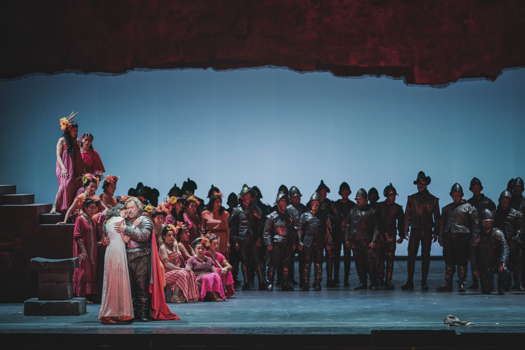 DISCUSSION: John Dante Prevedini leads a discussion about Composers, individuals or collective?, including contributions from David Arditti, Halida Dinova, Robert McCarney and Jane Stanley.
DISCUSSION: John Dante Prevedini leads a discussion about Composers, individuals or collective?, including contributions from David Arditti, Halida Dinova, Robert McCarney and Jane Stanley.
Florence Rediscovers a Masterpiece
GIUSEPPE PENNISI listens to
Gaspare Spontini's 'Fernand Cortez
ou La Conquête du Mexique'
Teatro del Maggio Musicale Fiorentino opened its 2019-20 season with Fernand Cortez ou La Conquête du Mexique by Gaspare Spontini in the original version as staged at the Académie Impériale de Musique on 28 November 1809 in the presence of Napoleon Bonaparte, who had inspired and implicitly commissioned it. I saw and listened to the opera on 20 October 2019 in a sold out opera house. It is a production that seriously deserves to be considered for the 'Abbiati Prize', the Italian Oscar award for operas. These are the reasons:
- The accurate critical edition by Federico Agostinelli for the Jesi Pergolesi Spontini Foundation, an edition based on the original manuscript. This allows us to discover how, in 1809, Spontini preceded many nineteenth century musical developments so much that Wagner himself took Spontini among his examples in theorizing 'the total work of art of the future'.
- Jean-Luc Tigneaud's musical direction. With the orchestra of the Maggio Musicale Fiorentino (and the chorus led by Lorenzo Fratini), he has made the modernity of the score explicit - for example, the dissonances and impervious passages as well as the contrasts between very strong and very delicate moments - even within the formal structure of a tragédie lyrique.
- A good vocal cast which has handled well the high and sometimes reckless texture requested by the composer, and which has shown generally good French diction, in a language often posing serious problems to singers who are not French natives.
- The intelligent dramaturgy and stage direction by Cecilia Ligorio who, while scrupulously respecting the music and the libretto, extracts modern and even topical elements from Spontini's work.
- The effective sets by Alessia Colossus and Massimo Checchetto, the costumes by Vera Pierantoni Giua and the lighting by Maria Domènech Gimenez. They do not attempt to replicate a grandiose show financed by the Imperial purse and intended to have hundreds of performances (like a Broadway musical today). Rather, they use the colours skilfully - for example, gravure, like in old prints, in the first Act, black and grey in the second, red in the third - to give, with elegance, the sense of the colossal, while respecting today's budget constraints.
- The choreography by Alessio Maria Romano and the Nuovo Balletto di Toscana which effectively gave life to dances that are an integral part of the opera.
This production has the signature of Cristian Chiarot, the Superintendent who, after relaunching La Fenice, took over a dying Maggio Musicale and was bringing it back to its ancient glory when, together with principal conductor Fabio Luisi, he was put, by local politics, into the position of having to resign.
Spontini produced various versions of Fernand Cortez. In 1809, the opera was meant to be almost a work of propaganda. It aimed at celebrating Napoleon as a courageous, bold, forward-thinking, generous and lenient leader in a Spain where the French would bring civilization by fighting fanatical and superstitious groups. This first version - rediscovered in Florence - was short-lived precisely because the events of the Spanish war took an unexpected turn, with the expulsion of the French army from the Iberian Peninsula.
Spontini resumed the work after the Restoration, and produced a new opera in 1817, moving scenes from one Act to another and introducing a new character: the Atzec King Montezuma. This version was a great success in France and circulated frequently in the rest of Europe until the end of the nineteenth century. In 1820 it was seen and heard at the San Carlo Theatre in Naples with Gioacchino Rossini in the pit and Isabella Colbran as female protagonist. Fernand Cortez had a great influence on Rossini, then composing Maometto Secondo, especially on his last opera Guillaume Tell. In an Italian rhythmic version, it was seen and heard in 1916 at La Scala, in 1951 at the San Carlo with Renata Tebaldi as female protagonist - in 2004 a remastered CD was released - and in 1983 in Jesi, Spontini's birthplace. A third German version was produced for the Berlin Royal Theatre in 1824, and a fourth version still for performances in France in 1832. In short, in various versions, the opera accompanied Spontini throughout his life.
Given the importance of this work in the history of music, it is fundamental to listen and see the original version of Fernand Cortez. I hope that from this Florentine staging a CD or DVD will be produced. Fernand Cortez is essential to understand not only French grand opéra but also historical operas by Verdi such as Les vêpres siciliennes and Don Carlos as well as those by Musorgsky - namely, Boris. It is also a key to the evolution of German romanticism from Weber, who directed it several times in German opera houses, to Wagner.
The plot presents the conquest of Mexico in a very politically incorrect manner: this bloody piece of history is read and presented as a liberation from the ignorance and cruelty of the native barbarians due to the good and honest Spaniards. However, a coup de théâtre by the stage director in Act III puts the historical developments into a more appropriate perspective.

A scene from Spontini's Fernand Cortez ou La Conquête du Mexique.
Photo © 2019 Michele Monasta
The historical developments are mixed with the love affair between the Atzec princess Amazily, converted to Christianity, and Cortez himself. Amazily is, moreover, sister of the Atzec general Télasco. There are opportunities for great 'special effects', such as the fire of the Spanish fleet, the Atzec temple for human sacrifices and battles, and for dances - even an equestrian ballet in which, in Spontini's time, specially trained horses and jockeys were employed.

A scene from Spontini's Fernand Cortez ou La Conquête du Mexique.
Photo © 2019 Michele Monasta
The stage sets reproduce these colossal aspects to best effect, taking into account the budgetary constraints of a modern opera house. I've mentioned already the richness of the score based on contrasts: the roaring of the cannons and the sound of brass and percussion alternates with the pianissimo of the strings. The harmonic aspects are quite innovative for an 1809 composition.
Impervious demands are made on the singers, especially for the role of Amazily, sung by Alexia Voulgaridou. She has several very beautiful arias but, as much in the arias as in the recitatives, duets and trios, she must always keep a very high texture. Among the protagonists, there are three tenors: a baritenor in the role of Cortez - Dario Schmunck, a lyrical tenor 'spinto' almost fit for a Verdi opera, in the part of Télasco - Luca Lombardo - and a light lyrical tenor as Alvar, Cortez's brother and prisoner of the Atzec - David Ferri Durà. All three sing at quite a good level: Lombardo has excellent diction and phrasing. André Courville - the Atzec Great Priest - and Gianluca Margheri as Moralez, Cortez's friend and confidant, are the two main bass baritones. All the others, in minor parts, were good.

A scene from Spontini's Fernand Cortez ou La Conquête du Mexique.
Photo © 2019 Michele Monasta
A large and attentive audience followed the four-and-a-half-hour performance with open stage applause after the main numbers. There were well-deserved ovations at the end.
Copyright © 23 October 2019
Giuseppe Pennisi,
Rome, Italy

FURTHER INFORMATION: GASPARE SPONTINI




